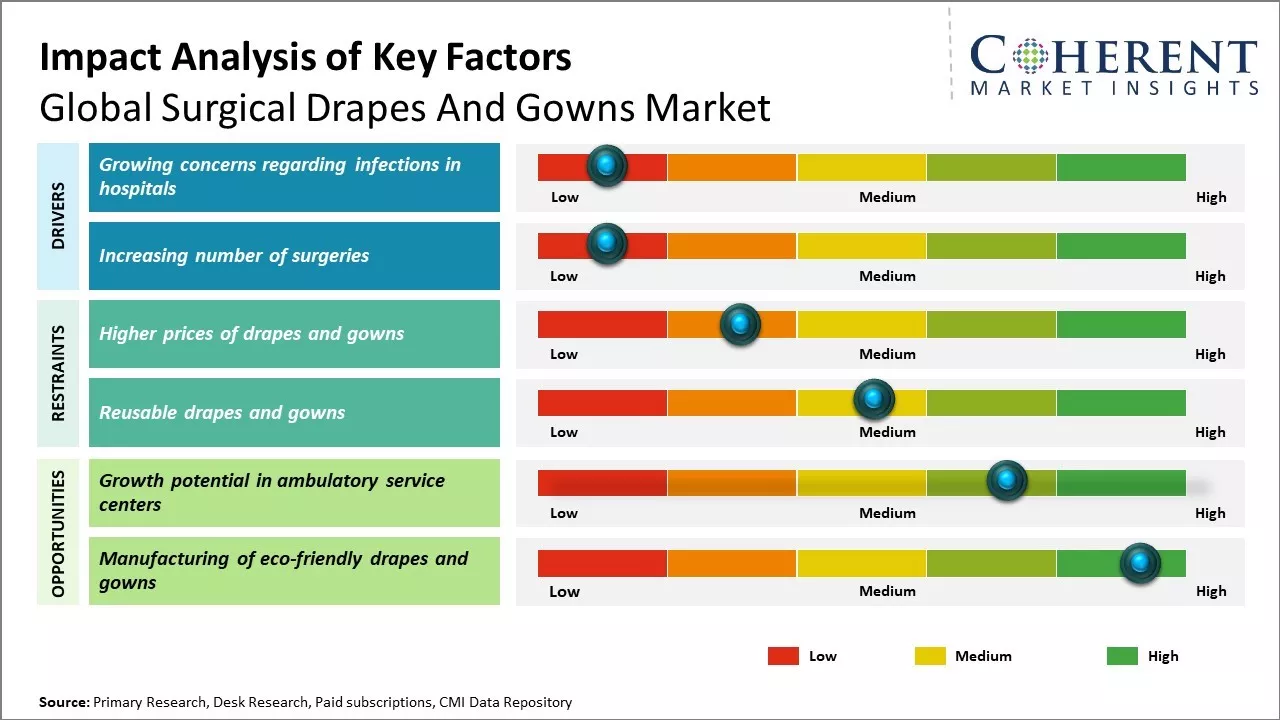The global surgical drapes and gowns market share is estimated to be valued at USD 3.37 Bn in 2025 and is expected to reach USD 4.88 Bn by 2032, exhibiting a compound annual growth rate (CAGR) of 5.4% from 2025 to 2032.

To learn more about this report, Download Free Sample
The surgical drapes and gowns market is expected to witness substantial growth over the forecast period. Key factors such as increasing number of surgical procedures performed worldwide on an annual basis and growing awareness regarding infection control in clinical settings are expected to drive surgical drapes and gowns market demand. Additionally, rising demand for nonwoven materials-based surgical drapes and gowns owing to their properties such as high liquid resistance, bacteria barrier, and breathability is further expected to support the revenue generation in the industry. Also, the growing adoption of surgical gowns and drapes due to regulatory compliance for infection control during surgeries will supplement the market expansion during the next few years. However, higher pricing of advanced surgical drapes and gowns and availability of cheaper substitutes may hamper the market growth to some extent.
|
Current Events |
Description and its Impact |
|
Regulatory and Trade Policy Shifts |
|
|
Industry Consolidation and Strategic Realignments |
|
Uncover macros and micros vetted on 75+ parameters: Get instant access to report
Between October 2023 and September 2024, India exported a total of 57 shipments of surgical drapes. These exports involved 16 Indian exporters and reached 18 international buyers.
In September 2024 specifically, India recorded 8 shipments of surgical drapes, representing a 167% increase compared to September 2023 and a 60% rise from August 2024.
In terms of product type, surgical drapes segment is expected to contribute 50.5% of the market share owing to its widespread applicability and cost-effectiveness. General procedure drapes are designed for use in basic surgical procedures that do not require specialized equipment or materials. Featuring universal design and basic constructs, general drapes can be utilized across a variety of routine operations from minor vascular access to abdominal examinations. Their versatility allows for use in over 50% of all surgical procedures performed globally each year. As a result, general drapes experience consistently high demand in hospitals, clinics, and ambulatory centers worldwide. In addition, general drapes offer an affordable solution for providers compared to more specialized drapes. Their simpler design translates to lower manufacturing costs which are then passed onto customers. This price advantage makes general drapes accessible for resource-constrained medical facilities in developing regions.
In November 2023, Manjushree Spntek launched HighTex Hybrid Spunmelt Nonwoven, fabricated on a world-first Reicofil RF smart composite line and enhanced with A.Celli’s resin-treatment technology. Designed for medical and hygiene applications, the multilayer composite delivers low lint, excellent barrier protection, breathability, and resistance to acids, bases, solvents, and chemicals. It also features high wet strength, biocompatibility, Class 1 flammability compliance, and options like alcohol-repellent and anti-static finishes meeting EN 13795 standards. The inner soft layer ensures comfort, while the outer layer shields against contaminants ideal for surgical drapes.
In terms of usage pattern, disposable is expected to contribute 60.5% of the market share in 2025 due to stringent infection control norms and convenience factors. Regulatory agencies worldwide have enacted strict guidelines in recent decades mandating the use of disposable drapes and gowns in surgical environments. This is aimed at limiting the spread of hospital-acquired infections through cross-contamination between patients. Disposable drapes and gowns engineered from breathable non-woven materials offer a reliable means to satisfy these hygienic standards through single-use applications. Additionally, disposable drapes and gowns alleviate the need for laundering and sterilization of reusable products.
For instance, a new production line for disposable surgical gowns made from non-woven fabric has been launched at a sterile dressing manufacturing enterprise in Turkmenistan’s northern Dashoguz velayat.
In terms of end user, hospitals & clinics is expected to contribute 70.5% of the market share in 2025 owing to the concentration of specialized surgical facilities and capacities in this segment. Hospitals serve as key access points for specialized and complex surgical procedures that require dedicated infrastructure and personnel. They house specialized operating rooms, catheterization labs, endoscopy suites and other critical care facilities equipped to handle a diverse surgical case load. Additionally, the shift towards super-specialty tertiary and quaternary care hospitals has boomed access to advanced surgery worldwide. Meanwhile, emerging multi-specialty clinic networks now deliver a wide range of surgical services previously concentrated in hospitals. Combined, these factors have expanded the physical footprint and case volumes handled within the hospitals & clinics segment globally.
For instance, Cardinal Health is advancing surgical safety with its latest innovations in drapes and gowns, developed by a specialized team within its Global Medical Products division. The team collaborates closely with clinicians to design products prioritizing sterility, ease of use, and protection in operating rooms.

To learn more about this report, Download Free Sample
The North America region currently dominates the global surgical drapes and gowns market. The region is expected to account for 40.8% of the market share in 2025. The presence of leading medical device manufacturers as well as established healthcare infrastructure and facilities have contributed to its large market size. With the U.S. being one of the largest healthcare spenders globally, there is immense demand for surgical drapes and gowns. According to the American Medical Association, in 2023, the United States spent USD 4.9 trillion on healthcare, representing 17.6% of the nation's Gross Domestic Product. This equates to approximately USD 14,570 per person. Furthermore, the region actively encourages medical research and development which further accelerates product innovations. This is further accelerating the surgical drapes and gowns market share.
The Asia Pacific region is projected to witness the fastest growth over the coming years. Majority of the leading market players are looking to establish their manufacturing bases in Southeast Asian countries to cater to the rising healthcare needs. With improving access to healthcare and growing medical tourism, countries like India and China offer lucrative opportunities. Additionally, their large population size along with increasing healthcare expenditures will drive further market penetration. For instance, Primewear® India is a well-established company specializing in the manufacturing and export of surgical disposable drapes and packs.
The pricing of surgical drapes and gowns is also comparatively lower owing to lower manufacturing costs. This makes the products more affordable for the providers and patients in Asia Pacific region as compared to developed markets. The region provides a favorable environment for sustained market expansion. If the same growth momentum continues, Asia Pacific may emerge as the dominant regional surgical drapes and gowns market share in the near future.
The U.S. market for surgical drapes and gowns is characterized by a high surgical volume, strict CDC and AAMI guidelines. Along with that, the U.S. has a widespread hospital-acquired infection (HAI) prevention protocol. In the United States, approximately 51.4 million inpatient surgical procedures are performed annually, according to the CDC. This includes a wide range of procedures, from arteriography and cardiac catheterizations to endoscopies and diagnostic ultrasounds. Additionally, there are roughly 31.5 million outpatient surgeries performed each year.
For instance, in January 2023, the Association for the Advancement of Medical Instrumentation (AAMI) revised its ANSI/AAMI PB70 standard “Liquid barrier performance and classification of protective apparel and drapes”. The update expands coverage to new PPE types beyond surgical and isolation gowns, including Surgical Gown–E, procedure gowns, decontamination gowns, full-coverage/open-back gowns, hoods, togas, and accessories like aprons and footwear covers. It also introduces clear labeling requirements indicating barrier level and coverage area, enabling clinicians to choose appropriately for infection-risk settings.
The surgical drapes and gowns market in UK is experiencing significant transformation, driven by a strong NHS surgical infrastructure and high demand for barrier-level gowns and procedure-specific drapes. The UK government has pledged £102 million to modernize and expand GP surgeries across England to boost capacity and patient access. This funding, part of a broader community care expansion initiative, follows rising concerns over limited surgery space and mounting demand for appointments. Health officials estimate the investment will support an additional 8 million GP appointments annually, alleviating pressure on local practices and reducing patient wait times.
For instance, in April 2025, Lohmann & Rauscher Group (L&R) acquired Unisurge International Ltd., a leading UK manufacturer of Custom Procedure Packs, disposable surgical products, drapes, gowns and instruments. With annual revenues of £48.5 million in 2024 and a workforce of over 280 across Newmarket and Castleford, Unisurge will operate as an independent L&R subsidiary.
India surgical drapes and gowns market is advancing rapidly, driven by rising surgical procedures, hospital expansion, government mandates for infection control. India has a high-volume demand for cost-effective disposable gowns and reusable options in rural regions. It's estimated that around 30 million surgical procedures are performed in India each year.
For instance, in April 2025, India is cementing its position as a global hub for disposable surgical drapes and gowns, thanks to the government’s “Make in India” initiative and surging domestic demand for infection-control PPE. Manufacturers such as Man‑Med are scaling up production of high-quality, ISO- and CE-certified gowns and drapes, increasingly supplying both local hospitals and export markets.

To learn more about this report, Download Free Sample
| Report Coverage | Details | ||
|---|---|---|---|
| Base Year: | 2024 | Market Size in 2025: | USD 3.37 Bn |
| Historical Data for: | 2020 To 2024 | Forecast Period: | 2025 To 2032 |
| Forecast Period 2025 to 2032 CAGR: | 5.4% | 2032 Value Projection: | USD 4.88 Bn |
| Geographies covered: |
|
||
| Segments covered: |
|
||
| Companies covered: |
Cardinal Health, Inc., 3M Health Care, Medline Industries, Inc., Mölnlycke Health Care AB, Thermo Fisher Scientific Inc., Steris plc, Paul Hartmann AG, Ahlstrom-Munksjö, Priontex, Lohmann & Rauscher GmbH & Co. KG, Guardian Surgical, Dynarex Corporation, Fullstar Non-Woven Products Co., Ltd., Winner Medical Co., Ltd., Alpha Pro Tech, Ltd., and Graham Medical |
||
| Growth Drivers: |
|
||
| Restraints & Challenges: |
|
||
Uncover macros and micros vetted on 75+ parameters: Get instant access to report
Growing concerns about hospital-acquired infections are a major factor boosting the global surgical drapes and gowns market. Hospitals aim to provide hygienic environments to patients during surgeries by effectively using surgical drapes and gowns. These products act as barriers and help prevent the spread of infections from patient to patient as well as from patient to staff members. According to the World Health Organization (WHO), on any given day, over 1.4 million people worldwide suffer from hospital-acquired infections. With the rising prevalence of such infections, hospitals and healthcare facilities are procuring more surgical drapes and gowns which are proven to significantly reduce pathogen transmission if used appropriately.
Surgical drapes and gowns allow medical professionals to easily isolate the surgical site and limit contact between non-sterile surfaces and the surgical area. Their use is evidence-based practice recommended by standards and guidelines set by health organizations. According to UNICEF, the shortage of essential medical supplies, such as surgical kits, remains a critical challenge in many developing countries as of 2025. However, with increased funding and awareness about infections, more hospitals globally are ensuring adequate supplies of surgical draping and gowning solutions which has boosted their overall demand. Going forward, the market is anticipated to witness continued growth. Advanced materials being used for manufacturing surgical draping and gowning products are adding an extra layer of protection.
The global surgical drapes and gowns market has been witnessing significant growth in recent years driven by the rising number of surgical procedures performed worldwide. With the growing geriatric population and increasing prevalence of chronic pain and lifestyle diseases, there has been a substantial increase in the demand for various types of surgeries such as cardiac, orthopedic, neurological, etc. The growing disease burden and improving access to healthcare are some of the key factors contributing to this rise in surgical volumes. For instance, cardiovascular diseases which often require surgical interventions such as cardiac bypass, heart valve replacement, etc. are reported to be the leading cause of death globally by the WHO. It is projected that by 2030, over 23 million cardiovascular procedures will be performed annually worldwide. This steady increase in surgical caseloads has led to a proportional rise in the utilization of surgical drapes and gowns across hospitals and ambulatory surgery centers. Surgical drapes and gowns market research highlights that innovations in material technology and infection control compliance are further propelling market demand.
A recent example includes Northwell Health’s 2025 operating room recycling program, which repurposes sterile drape and gown materials to reduce medical waste and improve sustainability, demonstrating how healthcare systems are also prioritizing environmental responsibility alongside sterility and safety. Surgical drapes are used to cover patients and surgical instruments in the operating room to maintain sterility and prevent contamination during procedures.
Ambulatory surgical centers are poised to drive significant growth in the surgical drapes and gowns market. Ambulatory or same-day surgery allows many procedures to be performed outside of a hospital setting, with patients able to return home the same day. This streamlines healthcare delivery and saves costs compared to traditional inpatient surgery. The number of ambulatory surgical centers has been increasing steadily over the past decade. As more complex surgeries migrate from hospitals to these centers, it increases the need for surgical drapes, gowns and other sterile products. According to a recent surgical drapes and gowns market forecast, this segment is expected to see robust growth through 2030, driven by increasing outpatient procedure volumes and infection control needs.
For example, in the U.S., Ambulatory Surgery Centers (ASCs) now perform more than 60% of all outpatient surgeries, with similar trends emerging in countries like India and Brazil. Healthcare systems globally are seeking ways to manage rising costs while still meeting patient demand. Same-day or ambulatory surgery addresses this need by freeing up expensive hospital beds for more serious cases. All of these factors are expected to further drive expansion surgical drapes and gowns market growth in the coming years.
The surgical drapes and gowns market value is quietly undergoing a structural shift, driven not by volume growth, but by value migration toward advanced barrier technologies, regulatory stringency, and sustainability integration. In my view, the future battleground will not be between low-cost providers, but between IP-driven innovators capable of balancing performance, disposability, and compliance.
Hospitals are also getting smarter in purchasing behavior, transitioning from “per-piece pricing” to procedure-based custom packs (CPTs). Cardinal Health and Mölnlycke have aggressively expanded CPT solutions, not for margin expansion alone, but because this gives them control of the surgical workflow, embedding their SKUs into the OR ecosystem. This is sticky revenue disguised as disposables.
From a regulatory standpoint, the EU MDR has become a litmus test. Manufacturers relying on basic CE-marked drapes will soon be filtered out unless they adhere to EN 13795 high-performance level standards. The upcoming tightening of clinical evidence requirements will tilt the market away from generic Asian OEMs toward regionally compliant manufacturers with traceability and clinical validation capabilities.
While disposability ensures sterility, the pressure from ESG-conscious hospital groups, particularly in the UK’s NHS and Scandinavia is leading to trials of reusable gowns with RFID tracking for lifecycle monitoring. Yet, reusables still represent <5% share globally. The real opportunity lies in biodegradable single-use nonwovens, such as Medline’s green-line drapes made from PLA-derived composites, which are seeing pilot adoption in France and Canada.
*Definition: The global surgical drapes and gowns market consists of medical textile products that are used as barriers to prevent cross-contamination between healthcare staff, patients and surgical equipment during medical procedures. Surgical drapes help create a sterile field during surgery while gowns protect healthcare professionals and patients from pathogens. Key products include disposable and non-disposable drapes and gowns used in hospitals, outpatient facilities, and other healthcare settings to maintain sterility and infection control standards.
Share
Share
About Author
Komal Dighe is a Management Consultant with over 8 years of experience in market research and consulting. She excels in managing and delivering high-quality insights and solutions in Health-tech Consulting reports. Her expertise encompasses conducting both primary and secondary research, effectively addressing client requirements, and excelling in market estimation and forecast. Her comprehensive approach ensures that clients receive thorough and accurate analyses, enabling them to make informed decisions and capitalize on market opportunities.
Missing comfort of reading report in your local language? Find your preferred language :
Transform your Strategy with Exclusive Trending Reports :
Frequently Asked Questions
Joining thousands of companies around the world committed to making the Excellent Business Solutions.
View All Our Clients